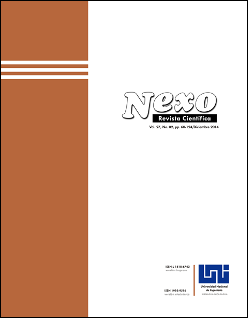Study of Red-mechanical cement compressive strength of bricks made from clay mixtures Portland
DOI:
https://doi.org/10.5377/nexo.v27i2.1945Keywords:
Absorption, Hydrated calcium silicates, Unitary weight, Spectrum, Compressive mechanical resistanceAbstract
A proposal for the development of handcrafted bricks of clay soil stabilized with gray portland cement, as an alternative to reduce the level of pollution caused by emissions of carbon dioxide from the use of wood as a source of combustion during the baking step of bricks is presented. The work was carried out in the soil bank of one brickyard located in La Paz Centro, Nicaragua. Moreover, two different brands of Portland cement were used. Cement/soil samples were prepared according to the established norms, and the mechanical-physical properties were compared with bricks cooked through a full mixed factorial design experiment. The parameters studied were ratios of cement /soil, water /cement binder and cement brand. The best results for samples of cement/soil reached resistances higher than 12 MPa after 28 days of curing and absorption percentages lower than 15%. Hydration products, responsible for the development of mechanical strength, were analyzed using infrared spectroscopy. The largest number of hydrated calcium silicate was obtained for samples with Canal cement.
Downloads
1729
Downloads
Published
How to Cite
Issue
Section
License
The authors who publish in Nexo Scientific Journal agree to the following terms:
- Authors retain the copyright and grant the journal the right of the first publication under the license Creative Commons Attribution License, which allows others to share the work with a recognition of the authorship of the work and the initial publication in Nexo Scientific Journal.
- Authors may separately establish additional agreements for the non-exclusive distribution of the version of the work published in the journal (for example, in an institutional repository or a book), with the recognition of the initial publication in Nexo Scientific Journal.
- Authors are allowed and encouraged to disseminate their works electronically (for example, in institutional repositories or in their own website) before and during the submission process, as it can lead to productive exchanges, as well as earlier and greater citation of published works.










